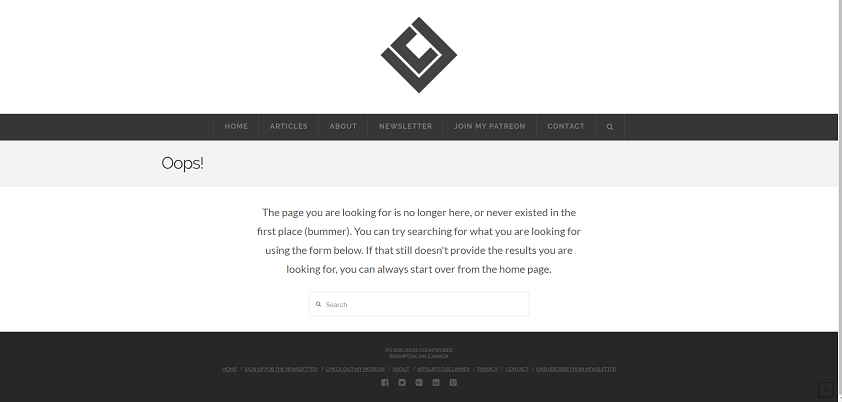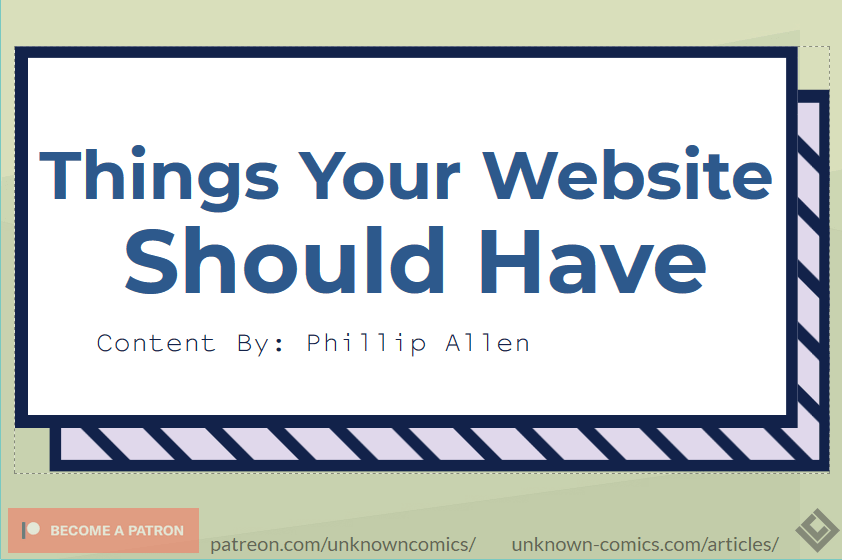Starting a website is time-consuming. Trying to figure out what bare minimum you need for a simple website can be a little frustrating. That’s where this article comes in, I’ll be talking about the few things your website should have for the typical comic creator.
Be it certain pages or content, what you’ll find here will give you a decent checklist of what to make sure you have on your website before launching it for the world to see.
Do note that depending on your design you may not even have web pages, to begin with (scrollspy websites are being used frequently). If that’s the case just make sure you’re offering this content somewhere for your website visitors to check out.
Let’s be clear, this article won't be listing out things like an e-commerce store or something significantly complex. I’m just going to make sure your site is functioning and holds the bare minimum amount of information your visitors will want to have available.
So, let’s begin.
Why Even Bother?
Well, maybe before we even begin I should explain why I am suggesting these options below.
Having what suggest below to be things your website should have will help give your site more authenticity and legitimacy to a visitor to your website.
Lots of websites out there don’t include even basic information or functions expected of a modern day web surfer.
Having a website that includes features and content expected in today’s web development (features of your site that respond to your visitor; i.e. clicking links, color changes, etc) and web design (makes your site look like it does; i.e. background colors, text alignment, text font, etc) standards add value to your site, your comic, and yourself.
Functions Your Website Should Have
Check That Your Links Work
This one is crucial for a modern site.
Checking that your links go to where they say (or where they can be expected to go) is very important. No web surfer wants to click a link and end up somewhere they didn’t expect. Much less ending up on one of your 404 pages.
The best way to check that they work is by… well… clicking them all yourself.
So, click away after you add a link to make sure it works fine.

Make It Responsive
This is one of those things your website should have. If it doesn’t, most people who visit your site on a mobile device will just be disappointed, frustrated, and just leave your site and think pretty little of you afterward.
In today’s day and age, even without any coding skills, it’s quite easy to get a website set up that's responsive to varying screen sizes. From mobile devices (phones, tablets, etc) to laptops and home PCs.
If you’re using a CMS (content management system) like Wordpress or Shopify it’s quite easy to find a theme (you can use either free themes found in the theme library or you can check out themeforest.net. that includes this feature in its core design. That means that you’ll never have to write a line of code to make it work this way.
On the case that you’re trying to code your site by hand (kudos if you do, it’s lots of fun) I’d recommend using Bootstrap. It’s helps set up the framework for designing and developing your website. It speeds things up quite significantly if you’re just starting out, trust me.
Content Your Website Should Have
About… Well, You
If your site is going to be all on one page, make sure you have a little section for the About Me and the About My Work.
No comic creator’s website feels complete unless you’ve dedicated some time to talk about yourself and your different comics.
Take this opportunity to open up, make yourself look like someone with interests, drives, experience, and someone who loves comics enough to make ‘em!
Make sure you spend the time to also dive deep into your different comic creating projects. The types of comics that they are, the types of series they fall into, their genre, a quick short brief about them. That and just about anything else you want to throw at your readers.
Like the article so far? Support the production of more articles like this one!
Contact Form
This is one of those things your website should have as well.
You can always go with substituting a contact form (which can be a hassle to get it to work right depending on the certain plugin, code, or email provider you’re hoping to use) with a plain email.
Why Contact Forms?
I strongly suggest getting a contact form to work instead because it can add a certain barrier to spammers if you set it up right. If you see the example I’ve provided of this site’s contact page you’ll see a little checkbox that says “I’m not a robot”.
This little thing helps a lot if you’re using Wordpress and you’re utilizing the very popular Contact Form 7 then I recommend you check out their link on reCAPTCHA to help set up this little feature.
Still Want To Just Offer An Email?
If you do, don’t worry I am not judging you.
Although, if you are going to go ahead and still just put your email down on your website I strongly recommend you make it functional.
Adding a short piece of code to an email text can make it an email link which responds by clicking and opens an email tool that you’ve set as your default. It also makes it easier to copy by right-clicking and selecting “copy email address”. For an example of this working check out this link from W3Schools.com.
Call To Action
A little less specific but nonetheless it’s very important to any comic creator to add a call to action on every page and sometimes every piece of significant content on their website.
I’ve discussed calls to action in the past here, but make sure you include it on your website as well. Be it on a sidebar, bottom of a blog post, in the bottom of your About or Contact page or section of your site.
It can be anything like telling your visitor to check out your blog to see any updates you’ve posted about your newest comic or a poster that asks the site visitor to join your crowdfunding (whichever type it may be) and so on.
A Blog
I won’t go much into this particular topic (because I want to write a whole article on it later down the line) but it’s important to note that every modern website should include a blog.
Most of you may not feel comfortable with this particular type of content, but hear me out.
A blog should at the very least be a consistent release of content that covers topics that you consistently want to write about (a lot of bolded words here).
This means that you shouldn’t commit to writing something if you don’t want to write it.
It also means that you need to set up a release schedule. For this site that release schedule is every two weeks on a Thursday evening EST (Eastern Standard Time). For your website it could be twice a week, once a week, once every two weeks, or once a month.
The key is consistency… Also grammar and proper spelling. I recommend Grammarly for that (it’s what I use)!
Conclusion
Like I said, making a website is a time-consuming endeavor that can lead to a lot of frustration.
But hopefully this article has helped you figure out a couple of features and few types of content your website should have.
Sign Up For
The Unknown Times!
Content Updates
Website News
Recommended Reading
And More to Come!
*Once every two weeks!*
Liked the article? Become part of my Patreon Community!
About The Author

Phillip Allen
Writer, Editor, and Founder of Unknown Comics
Hello there! My name is Phillip Allen and I'm the writer, editor, and founder of Unknown Comics. I am an aspiring comic book creator. In an attempt to learn how to create my own comic I came to learn just how few reliable resources existed out there. From a few books and unhelpful websites I decided to focus my attention on researching and writing a resource for both myself and the rest of the comic creating industry. This website and and its content is the result of all of that hard work.

